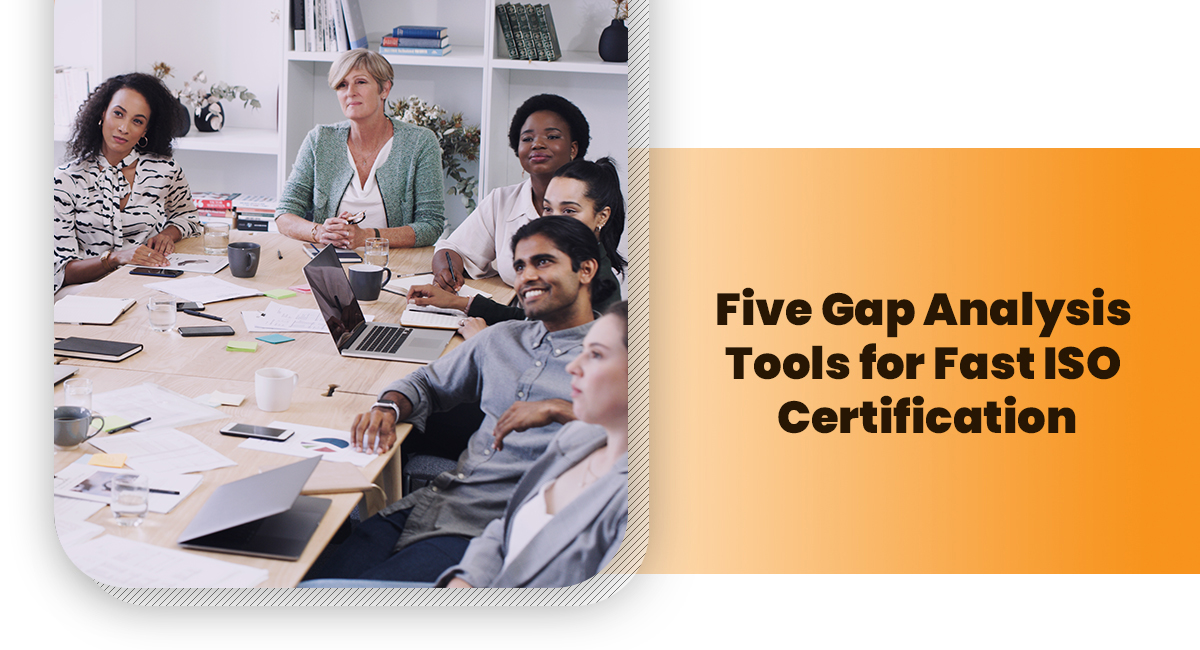Five Gap Analysis Tools for Fast ISO Certification

Your business will be considered competent if your company’s management system standards match the ISO benchmark. ISO certifications function as competitive advantages that secure your position in the market. Quality management, risk assessment, and control, business continuity management, information security, environmental, and occupational health and safety are some of the top ISO systems. A gap analysis is the first crucial step for preparing your management system to meet the global standard.
Gap detection is a thorough inspection that helps the governing body determine the difference between the current and ideal state of management. Gap analysis is the easiest and fastest way to identify root causes of problems in your existing system.
To make an error-free judgment out of the analysis, the management needs to select an effective tool for conducting the entire evaluation. There are precisely five tools that are cost-effective and time sensitive. The following post will outline five mechanisms with the aim of this blog being to list the effective functionalities of those tools.
Five Gap Analysis Tools
Tool 1 – SWOT Analysis
SWOT stands for strengths, weaknesses, opportunities, and threats. The analysis is performed to tally the threat factors with the opportunities and existing strength aspects. The analysis can be done through both quantitative and qualitative evaluations. In terms of finding the difference between the present system’s performance and the objectives, SWOT analysis provides the fastest result. It will highlight any weakness and risk factors associated with them. This way, the fundamental causes of the issues are determined. The following table is the template for performing the analysis.
| Strength – Cash reserves, inclusive web presence, solid customer base | Weaknesses – lack of competence, weak social media presence |
| Opportunities – Market expansions, competitive strength | Threats – government intervention, emerging competitors, cyber threats, and emergency situations |
Tool 2 – PEST Analysis
PEST stands for four external aspects, which have a serious impact on the business and management system. They are political, economic, sociological, and technological. Risks and opportunities associated with each of these external factors are examined. For a detailed gap analysis, the assessment helps to identify as well as eliminate the gap by pinpointing the current issues oriented with each of these segments. For successful gap detection, companies often perform both the SWOT and the PEST analysis.
Tool 3 – Fishbone Diagram
The whole point of conducting a gap analysis is to determine the causes behind the gaps. The Fishbone diagram is the most relevant and fast tool to find out the root causes. To determine the causes, the diagram has precise categories for investigations. They are as follows.
- People
- Machine
- Measurement
- Materials
- Methods
- Environment
You can select all of them or can focus on any according to the context of your organization.
Tool 4 – McKinsey 7’ Framework
This framework concentrates on the objectives and checks the functionalities of your management system to show whether your expectations are being met or not. The McKinsey 7’s Framework works on the following seven organizational factors to determine which values have not been met.
- Strategy
- Structure
- Systems
- Skills
- Shared values
- Style
- Stuff
The framework precisely concentrates on the aspects where your company excels. Therefore, it helps to build strategies so that it becomes easy for your management to take corrective actions accordingly. For quality management, the sevens model is the best choice to apply.
Tool 5 – Nadler-Tushman
Nadler-Tushman is the most robust framework that offers a comprehensive view of the overall gap. It shows how the business process is affecting each other. The analysis focuses on the gaps that directly impact productivity and revenue. For risk assessment and quality assurance-related gap analysis, the Nadler-Tushman process is often selected. According to this assessment, your company can only fill the identified gaps, when the components of the policies 100% align with the operations.
Final words
To find the most relevant tool for an effective gap analysis, call the expert professionals from ComplianceHelp Consulting LLC. They are the US’s premium ISO consultancy provider that offers customized solutions. From gap detection to audit, the resolute team provides holistic support to help you achieve 100% compliance in just 30 days. Hire the consultants and find the right gap evaluation mechanism.


